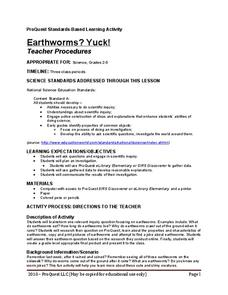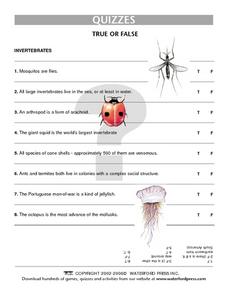Biology Junction
Segmented Worms - The Earthworm
In this biology worksheet, students color and label the different parts of an earth worm. They complete 41 short answers and fill in the blank questions about earthworms.
Curated OER
The Earthworm
In this science related learning exercise, students complete a wide variety of interactive activities associated with earthworms and their inhabitants.
Curated OER
Invertebrate Diversity
Comparative anatomy prevails in the lesson exploring diversity among invertebrates. Biologists examine physical characteristics of an earthworm from phylum annelida and a meal worm from phylum insecta. They also inspect a cricket and a...
Curated OER
What Are Cells?
Energize the cells of young biologists with an edible life science activity. Engaging students in exploring the inner workings of plant and animal cells, this activity involves using colored jello and various sweet and...
North Clackamas Schools
Sorting Living and Nonliving Objects
Is a rock living? How about lima beans? You'll find everything you need for an interactive sorting activity exploring living and non-living things.
Curated OER
Segmented Worms
In this segmented worms instructional activity, high schoolers will review the characteristics of segmented worms including the earthworm, bristleworm, and leech. This instructional activity has 7 fill in the blank, 3 true or false, and...
Curated OER
Investigating an Enzyme-controlled Reaction: Catalase and Hydrogen Peroxide Concentration
Are you looking for a way to measure cellular respiration? Try it with pureed potatoes. With some standard high school science equipment, biologists can perform an investigation and collect data surrounding byproducts of respiration. You...
Curated OER
The Human Impact on the Environment
Despite the typos and formatting issues, the Word document found here has some great potential. There are two questions that ask learners to put several events in a logical order; these could easily be made into a card sort activity....
Curated OER
Watering Soil
In this watering soil worksheet, students complete a simple activity, following directions to use a watering can to sprinkle, pour slowly, then pour "faster" onto soil and write about what they notice. Teacher guide is on page 2.
Curated OER
Composting
In this recognizing items that can be composted activity, students identify organic items that can be composted, write items that can be composted for each of the letters in the word compost, and make a list of vegetables and fruits....
Curated OER
Eastern Screech Owl
In this screech owl worksheet, students complete activities to learn about screech owls after reading Screech Owl at Midnight by C. Drew Lamm. Students learn how to attract owls, investigate owls in their community, and define words...
Curated OER
Reading - Glaciers
In this online interactive glaciers worksheet, students respond to 10 fill in the blank and multiple choice questions regarding the information included in the provided paragraphs.
Curated OER
Word Grid
For this soil worksheet, students find words that represent soil words in a word search. Students search for 9 words in this word search.
Curated OER
Which One is an Insect?
In this science instructional activity, students categorize 18 words as either insects or not insects. Students write the words in a two-column chart under the correct category.
Curated OER
Bug Detective
What happens when a living thing dies? After reading a paragraph of background knowledge on the life cycle of bugs, third and fourth graders work through four clues to figure out which bug is which. When they finish, they can study the...
Curated OER
Preprimer Word List
In this preprimer word list worksheet, students color the words in the list and draw a line to connect matching words. Students do this for 10 words.
Curated OER
Quiz: Invertebrates
In this science worksheet, 3rd graders will focus on invertebrates. Students will respond to eight true/false questions about these animals.
Curated OER
Cells
In this scientific investigation activity, students follow the provided procedures to examine the number of cells in animals and then respond to 3 short answer questions.

















